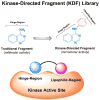Fragment-Based Discovery of a Dual pan-RET/VEGFR2 Kinase Inhibitor Optimized for Single-Agent Polypharmacology
- PMID: 26126987
- PMCID: PMC4535927
- DOI: 10.1002/anie.201501104
Fragment-Based Discovery of a Dual pan-RET/VEGFR2 Kinase Inhibitor Optimized for Single-Agent Polypharmacology
Abstract
Oncogenic conversion of the RET (rearranged during transfection) tyrosine kinase is associated with several cancers. A fragment-based chemical screen led to the identification of a novel RET inhibitor, Pz-1. Modeling and kinetic analysis identified Pz-1 as a type II tyrosine kinase inhibitor that is able to bind the "DFG-out" conformation of the kinase. Importantly, from a single-agent polypharmacology standpoint, Pz-1 was shown to be active on VEGFR2, which can block the blood supply required for RET-stimulated growth. In cell-based assays, 1.0 nM of Pz-1 strongly inhibited phosphorylation of all tested RET oncoproteins. At 1.0 mg kg(-1) day(-1) per os, Pz-1 abrogated the formation of tumors induced by RET-mutant fibroblasts and blocked the phosphorylation of both RET and VEGFR2 in tumor tissue. Pz-1 featured no detectable toxicity at concentrations of up to 100.0 mg kg(-1), which indicates a large therapeutic window. This study validates the effectiveness and usefulness of a medicinal chemistry/polypharmacology approach to obtain an inhibitor capable of targeting multiple oncogenic pathways.
Keywords: inhibitors; kinases; medicinal chemistry; polypharmacology.
© 2015 WILEY-VCH Verlag GmbH & Co. KGaA, Weinheim.
Figures
Similar articles
-
Targeted activity of the small molecule kinase inhibitor Pz-1 towards RET and TRK kinases.Sci Rep. 2021 Aug 9;11(1):16103. doi: 10.1038/s41598-021-95612-4. Sci Rep. 2021. PMID: 34373541 Free PMC article.
-
Bioisosteric Discovery of NPA101.3, a Second-Generation RET/VEGFR2 Inhibitor Optimized for Single-Agent Polypharmacology.J Med Chem. 2020 May 14;63(9):4506-4516. doi: 10.1021/acs.jmedchem.9b01336. Epub 2020 Apr 28. J Med Chem. 2020. PMID: 32298114 Free PMC article.
-
Ponatinib (AP24534) is a novel potent inhibitor of oncogenic RET mutants associated with thyroid cancer.J Clin Endocrinol Metab. 2013 May;98(5):E811-9. doi: 10.1210/jc.2012-2672. Epub 2013 Mar 22. J Clin Endocrinol Metab. 2013. PMID: 23526464
-
Targeting Rearranged during Transfection in Cancer: A Perspective on Small-Molecule Inhibitors and Their Clinical Development.J Med Chem. 2021 Aug 26;64(16):11747-11773. doi: 10.1021/acs.jmedchem.0c02167. Epub 2021 Aug 17. J Med Chem. 2021. PMID: 34402300 Free PMC article. Review.
-
Current review of small molecule Ret kinase inhibitors.Mini Rev Med Chem. 2010 Feb;10(2):138-46. doi: 10.2174/138955710791185154. Mini Rev Med Chem. 2010. PMID: 20105131 Review.
Cited by
-
Chasing the Target: New Phenomena of Resistance to Novel Selective RET Inhibitors in Lung Cancer. Updated Evidence and Future Perspectives.Cancers (Basel). 2021 Mar 4;13(5):1091. doi: 10.3390/cancers13051091. Cancers (Basel). 2021. PMID: 33806299 Free PMC article. Review.
-
Targeted activity of the small molecule kinase inhibitor Pz-1 towards RET and TRK kinases.Sci Rep. 2021 Aug 9;11(1):16103. doi: 10.1038/s41598-021-95612-4. Sci Rep. 2021. PMID: 34373541 Free PMC article.
-
Analysis of Pz-1, a promising therapeutic for organophosphorus poisoning from rodent plasma by liquid chromatography-tandem mass spectrometry.J Pharm Biomed Anal. 2025 Mar 15;255:116650. doi: 10.1016/j.jpba.2024.116650. Epub 2024 Dec 26. J Pharm Biomed Anal. 2025. PMID: 39793368
-
Synthesis of Constrained Heterocycles Employing Two Post-Ugi Cyclization Methods for Rapid Library Generation with In Cellulo Activity.ChemistrySelect. 2017 Dec 11;2(35):11821-11825. doi: 10.1002/slct.201702179. Epub 2017 Dec 19. ChemistrySelect. 2017. PMID: 30140731 Free PMC article.
-
Bioisosteric Discovery of NPA101.3, a Second-Generation RET/VEGFR2 Inhibitor Optimized for Single-Agent Polypharmacology.J Med Chem. 2020 May 14;63(9):4506-4516. doi: 10.1021/acs.jmedchem.9b01336. Epub 2020 Apr 28. J Med Chem. 2020. PMID: 32298114 Free PMC article.
References
-
- Capdeville R, Buchdunger E, Zimmermann J, Matter A. Nat Rev Drug Disc. 2002;1:493–502. - PubMed
-
- Lito P, Rosen N, Solit DB. Nat Med. 2013;19:1401–9. - PubMed
-
- Shah NP, Tran C, Lee FY, Norris D, Chen P, Sawyers CL. Science. 2004;305:399–401. - PubMed
- Zhou W, Ercan D, Chen L, Yun CH, Li D, Capelletti M, Gary N. Nature. 2009;462:1070–4. - PMC - PubMed
- Balbas MD, Evans MJ, Hosfield DJ, Wongvipat J, Arora VK, Watson PA, Sawyer CL. eLife. 2013;2:e00499. - PMC - PubMed
Publication types
MeSH terms
Substances
Grants and funding
LinkOut - more resources
Full Text Sources
Other Literature Sources





